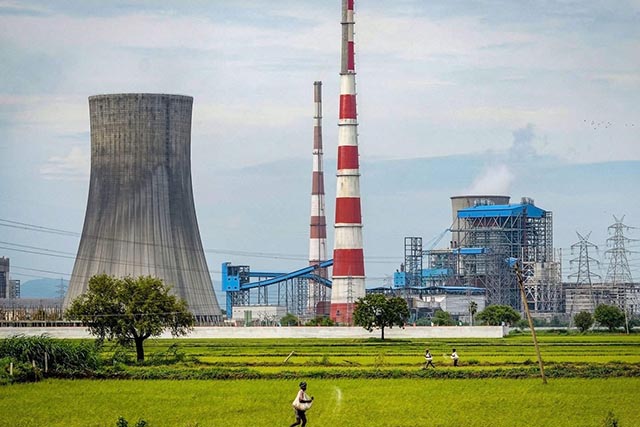A new study said that Bangladesh 's plan for significant addition of coal- and LNG-fired power plants will cause substantial overcapacity, with major financial implications.
The country already has excess power production in fiscal 2018-19 with just 43 per cent usage of energy.
And this low use even before the coronavirus outbreak resulted in Tk 9,000 crore($1.1 billion) capacity payments to sit idle for power plants, requiring both government subsidies and hikes in the price of electricity to consumers.
According to the study by the Ohio-based Institute for Energy Economics and Financial Analysis (IEEFA), the pandemic-induced lull is currently significantly reducing power demand, increasing financial stress on the Bangladesh Power Development Board (BPDB) through revenue reduction while capacity payments to idle plants have to be maintained.
"Based on our own forecast of power demand growth, which takes the economic impact of the COVID-19 into account, we calculate that Bangladesh is on course to have capacity that can generate 58 percent more power than the nation needs by 2030," said Simon Nicholas, the lead author of the study report and an energy finance analyst at the IEEFA in Australia.
Overcapacity is a situation in which the power sector of a nation can not sell as much as its power plants are designed to produce.
The impact of COVID-19 will also mean that long-term demand for power would be lower than forecast, making overcapacity worse by 2030 if the current plan for coal-fired and liquefied natural gas (LNG)-based power additions continues as usual.
"A long-term switch from cheap domestic gas towards more expensive imported coal and LNG, combined with the severe, long-term overcapacity Bangladesh is on course to see subsidies continue to rise," Nicholas said in a press release.
The study found that power tariffs for consumers could also be expected to increase. It argues that large fleets of large coal and LNG plants are increasingly less suited to meet lower-than - expected demand growth in developing nations.
Sara Jane Ahmed, co-author of the report, points out that there are important lessons for Bangladesh from the experience of Indonesia, which is suffering the financial impact of over-reliance on coal power.
PLN, an Indonesian state-owned power utility, has seen its over-commitment to coal power lead to a rapid increase in government subsidies, which reached an enormous $5 billion in 2018, said Ahmed, an energy finance analyst at IEEFA in the Philippines.
Indonesia 's Power Development Plan includes an overestimated forecast of growth in power demand for 2019-2028.
Such mis-forecasts have been compounded over time and are the basis for planning too much power capacity development , resulting in overcapacity, higher capacity payments, subsidies and tariffs.
The study draws on similarities with the rapidly escalating financial crisis of BPDB resulting from the existing overcapacity while pushing ahead with the completion of the Payra coal plant.
Half of Payra 's capacity will remain idle, forcing BPDB to make additional payments of Tk 160 crore per month.
"Bangladesh needs to heed to these lessons," Ahmed said.
In Bangladesh, by 2041, 35 per cent of the electricity generated from coal as primary energy will now be 1.7 per cent, according to IEEFA and the annual report of the state-run Coal Power Generation Company of Bangladesh.
Considering the future demand for electricity, the government has taken initiatives to build around 9,000 MW by 2030 and 20,000 MW by 2041 coal-fired power plants in both the public and private sectors.
Bangladesh is currently producing 2,750 million cubic feet of gas per day against a demand of 3,850 mmcfd and an expected demand of 6,713 mmcfd in 2041, according to state-run Rupantarita Prakritik Gas Company.
The country is looking to import LNG to bridge the gap between local production and demand in the midst of rapidly depleting natural gas resources and insignificant new gas discovery.
According to the study, it is now time for Bangladesh to consider more appropriate modular renewable energy (without capacity payments) and grid investments to meet lower demand growth and reduce overall system costs while improving domestic energy security and resilience.
"Bangladesh is well-positioned to take advantage of deflationary renewable energy to reduce overall system cost and provide affordable energy to households and industry."
The amount of land suitable for renewables in Bangladesh is likely to be higher than previously assumed.
However, some tough land use choices may have to be made if Bangladesh is to avoid establishing a power system dominated by expensive imported coal and LNG with higher power tariffs and government subsidies.
The COVID-19-induced delay to coal power projects allows Bangladesh to reset energy development policy and redirect resources to support economic fundamentals and energy price stability, the study said.
The cost of renewable energy is decreasing in Bangladesh and, with good government support and commitment, the cost of renewable energy will fall even further, as has been seen in other parts of South Asia.
There is a common assumption that Bangladesh does not have land available for large wind and solar projects, although some data indicates that there are more suitable sites available than previously believed.
A study in 2019 found that the maximum installed capacity was: onshore wind 16 gigawatts (GW), offshore wind 134GW, solar photovoltaic roof 35GW, solar photovoltaic power 156GW and floating photovoltaic power 31GW.
"With neighbouring India well ahead in its transition towards renewable energy, importation of ever-cheaper wind and solar power from Indian states could be part of the long-term solution," the report said.
Globally and regionally in South Asia, renewable energy is already less than two thirds of the cost of imported fossil fuels.
Given that solar module prices are likely to fall by 5-10 per cent over the next decade, not only will renewable energy soon be the cheapest form of new power generation in Bangladesh, but it will also quickly build up, while not adding to air pollution or carbon emissions.


































